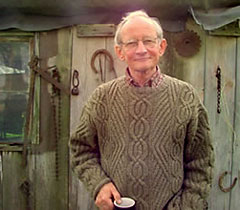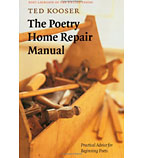|
Fine-Tuning Metaphors
With U.S. Poet Laureate Ted Kooser  ©Sarah Greene
©Sarah GreeneIn his book The Poetry Home Repair Manual: Practical Advice for Beginning Poets, the Pulitzer Prize winning poet Ted Kooser talks about one of his favorite figures of speech: the metaphor. “If you think of a metaphor as being a bridge between two things,” he writes, “it’s not the things that are of most importance, but the grace and lift of the bridge between them, flying high over the surface.” The author of ten collections of poetry, including the Pulitzer winner Delights and Shadows (Copper Canyon Press, 2004), Kooser has come to be regarded in many circles as a master of metaphor.
Literary Cavalcade recently spoke with Ted Kooser about The Poetry Home Repair Manual and how metaphors work.
 Courtesy University of
Courtesy University of
Nebraska Press LC: Why did you call your book The Poetry Home Repair Manual?
TK: I wanted to suggest that, in fact, poetry was something that you put together with tools of one kind or another, and maintained with tools, and so on.
LC: What’s the biggest difficulty that young poets have with metaphor?
TK: All too often I find the students with whom I work can come up with a metaphor that’s really pretty good and then they simply don’t follow it through and don’t put it to use in all the ways it could be used. They just drop it in like a…like a bead on a string. It’s important to really integrate it, to weave it into the poem in such a way that it reaches all the corners.
LC: How do you think metaphors work?
TK: Generally metaphors are very obvious things like, “That car is apple red.” There’s not much distance between the red of the car and the red of the apple. And so the thrill of the metaphor is not as pronounced as it is in really daring metaphor, where the red of the apple is something far afield from itself, so that there’s a bigger leap between one side and another. If you can pull it off, then it becomes almost…breathtaking.
LC: What are some other difficulties with metaphor?
TK: You see a lot of inadvertent inappropriateness in metaphor. This journalist whom I knew had gone out to cover a train derailment, and there were a lot of rail cars that had been dumped and turned on their sides. He was looking at it from an aerial view and he said that it looked like a worm with a lot of other maggot like worms nursing at it. Well, it was an attempt at metaphor, but it was completely inappropriate in a setting where people had been injured. It’s that sort of thing that I think we have to guard against: getting so literary and fascinated with our literariness that we turn out to be sort of ridiculous.
LC: In your book, you talk about how metaphors have their own internal logic. What happens when the logic of a metaphor breaks down?
TK: It doesn’t mean you have to chuck the metaphor. It just means you have to be very careful about introducing something on one side that won’t work on the other.
LC: Let’s talk about one of your poems that centers on a metaphor, “A Rainy Morning,” from Delights and Shadows. In it, you compare a woman in a wheelchair to a pianist.
TK: Interestingly, when I was getting the manuscript ready for Delights and Shadows, I had that as the very first poem. And Michael Wiegers, who was editing at Copper Canyon, didn’t want that poem to appear first. And the reason is that his mother is in a wheelchair and he said, “I see nothing beautiful about this, about a woman in a wheelchair.” And I said, “Oh, come on, Michael. I’m certainly not going to take this poem out. I like it very much.” I just buried it a little deeper in the book. But it struck me as being interesting that someone would respond that way. What I am trying to do in that poem is recognize the dignity, the beauty even, of making that kind of an adjustment in your life, where you have to learn to navigate in a different way.
A Rainy Morning
A young woman in a wheelchair,
wearing a black nylon poncho spattered with rain,
is pushing herself through the morning.
You have seen how pianists
sometimes bend forward to strike the keys,
then lift their hands, draw back to rest,
then lean again to strike just as the chord fades.
Such is the way this woman
strikes at the wheels, then lifts her long white fingers,
letting them float, then bends again to strike
just as the chair slows, as if into a silence.
So expertly she plays the chords
of this difficult music she has mastered,
her wet face beautiful in its concentration,
while the wind turns the pages of the rain.
“A Rainy Morning,“ from Ted Kooser’s Delights and
Shadows (Copper Canyon, 2004), is reprinted by permission of
the author. LC: It seems that the metaphor in this poem starts with a specific type of shared movement?
TK: There’s that line, “This difficult music she has mastered.” The woman in the wheelchair is perhaps no longer aware of the mastery, that it has become a part of her, in the same way that playing the piano becomes part of a pianist. They are not consciously deliberating about those movements anymore. They are natural, but they are effective.
LC: In The Poetry Home Repair Manual, you cite an early draft of a poem, “The Possible Lives,” in which you use a metaphor in a first draft, and then—in another draft—revise the metaphor into a simile. Could you talk more about that decision?
TK: Well, sometimes it’s important to advise the reader that you are about to move into an elaborate figure of speech, rather than just leap headlong into it. I just was in Chicago and I did a workshop there with some poets. And there was a poet who used an extended metaphor, a poem that ran 30 lines. It began by setting up the metaphor, but then the metaphor was so long and extended that the metaphor became the reality, rather than the initiating subject. And it just sort of slid off into a different thing altogether. There are times when you need to say to the reader: “OK, here’s what I’m going to do with you. I’m going to take you into this metaphor, and I want you to be aware that we’re still talking about the original subject.” In “The Possible Lives,” my fear was it had gotten out of control that way.
Ted Kooser on “The Possible Lives” from The Poetry Home Repair Manual:
There are also instances in which poets decide whether to use a simile or a metaphor based upon clarity. Here is an early draft of a poem of mine that eventually appeared in The Hudson Review.
The Possible Lives
There were once so many I might choose among,
a warehouse of coats and shoes, and all my size.
Walking the streets I imagined myself in every house,
happy with whichever woman might be living there.
How might it be to be at home among the odors
of a hundred different lives, opening the curtains
each morning to a different view? Now I know
that this life I have is the only one I have ever had
or will ever be given, a cord of braided dreams
that I follow, hand over hand, into the distance.
When I looked at this poem after giving it a few days’ rest, I noticed that it wasn’t clear just what I was talking about in those first two lines. Because I’d used “a warehouse of coats and shoes” it could be read literally, that I was choosing among coats and shoes and not possible lives, which I meant to be addressing. So I made the change to a simile and made it clear what I was trying to say:
There were once so many I might choose among,
like a warehouse of coats and shoes, all my size.
”The Possible Lives,” from Ted Kooser’s The Poetry
Home Repair Manual (University of Nebraska Press, 2005), is
reprinted by permission of the author.
LC: When did you write that poem?
TK: Oh. It isn’t very old. I’d say it might be four years old. I wrote it and it was in The Hudson Review about three years ago.
LC: There’s something sobering about those last two lines, given that many of your poems are explorations of life’s possibilities.
TK: I’ll tell you, I wrote that poem…the original material for it I wrote in a letter to Carol Bly [author and writing instructor]. Carol and I had been going through—back in ‘98 and ’99—we were going through radiation therapy at the same time, she in Minnesota and I down here in Nebraska. She was fighting breast cancer, and I had this other kind. So, I don’t know at what point I wrote that letter to her, but it was the idea that here we are, people in our sixties, and there was at the moment I wrote that poem a recognition that all of a sudden I’ve gotten to an age at which there aren’t a field of infinite possibilities left. So in that sense the poem is sort of bleak. And yet I guess you’re right, I’m still day dreaming about other possibilities, even though I’m recognizing that the tracks are narrowing and narrowing and narrowing.
 |
Your Turn
LC asked Kooser to come up with a writing exercise on metaphor. Here is one of his favorites! Follow these steps and build bridges between dissimilar things!
STEP 1: Brainstorm a list of totally dissimilar things.
STEP 2: Pick the two things from your list that are the most dissimilar and try to figure out if there are any relationships between them at all. Make a list of similarities.
STEP 3: Start drafting a short poem that shows the relationship between your two subjects. Make sure each detail works logically on both sides of the metaphor!
STEP 4: Ask a friend or classmate to test the logic of your metaphor. Are there places where your metaphor is weak or where you’ve introduced a detail on one side that does not apply to the other?
STEP 5: Based on this feedback, revise your poem until it reads like a clear bridge between two dissimilar things.
STEP 6: Proof and polish your poem. Then submit
it for publication on Write It!
|
 |
 |
|

